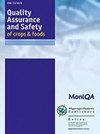Effects of fat meat and storage temperature on the qualities of frozen minced beef products
IF 5.3
3区 农林科学
Q1 FOOD SCIENCE & TECHNOLOGY
引用次数: 10
Abstract
The purpose of this study was to identify the ideal storage period for frozen minced beef products and to under-stand key factors affecting their quality. Frozen minced beef products with 10 and 15% of fat content were kept at ?5, ?15, and ?23°C, and over a 6-month period, they were assessed for moisture content (MC), peroxide values (POV), acid values (AV), 2-thiobarbituric acid (TBA) value, total volatile basic nitrogen content (TVB-N), and the sensory test in order to identify the effect on quality. This helped to determine their appropriate storage duration at a given temperature. Multiple regression analysis was used to assess the correlations between storage tempera-ture, fat meat percentage, characteristic factors, and overall acceptance (OA). Five months for ?23°C, 4 months for ?15°C, and 2 months for ?5°C met 3.7 points or more of OA, in accordance with global sensory analysis stan-dards, and were determined as acceptable frozen storage durations. The very high multiple regression analysis R2 (0.97–0.99) verified the correlation between the characteristic factors and OA. In addition, TVB-N, MC, and POV, respectively, were the main quality factors affecting OA at ?5, ?15, and ?23°C (R2 > 0.8). These findings may prove useful and practical for manufacturers to improve storage and distribution practices in maintaining the quality of frozen minced beef products.肥肉和贮藏温度对冷冻肉糜品质的影响
本研究的目的是确定冷冻牛肉糜产品的理想储存期,并了解影响其质量的关键因素。脂肪含量分别为10%和15%的冷冻碎牛肉制品被保存在?5.15,和?23°C,在6个月的时间里,评估它们的水分含量(MC)、过氧化值(POV)、酸值(AV)、2-硫代巴比妥酸(TBA)值、总挥发性碱性氮含量(TVB-N)和感官测试,以确定对质量的影响。这有助于确定它们在给定温度下的适当储存时间。多元回归分析用于评估储存温度、肥肉百分比、特征因素和总体接受度(OA)之间的相关性。五个月?23°C,4个月?15°C,2个月?根据全球感官分析标准,5°C符合3.7点或更多的OA,并被确定为可接受的冷冻储存时间。非常高的多元回归分析R2(0.97–0.99)验证了特征因素与OA之间的相关性。此外,TVB-N、MC和POV分别是影响OA的主要质量因素?5.15,和?23°C(R2>0.8)。这些发现可能对制造商改进储存和分销做法以保持冷冻碎牛肉产品的质量有用且实用。
本文章由计算机程序翻译,如有差异,请以英文原文为准。
求助全文
约1分钟内获得全文
求助全文
来源期刊

Quality Assurance and Safety of Crops & Foods
FOOD SCIENCE & TECHNOLOGY-
CiteScore
4.60
自引率
7.50%
发文量
61
审稿时长
1 months
期刊介绍:
''Quality Assurance and Safety of Crops & Foods'' is an international peer-reviewed journal publishing research and review papers associated with the quality and safety of food and food sources including cereals, grains, oilseeds, fruits, root crops and animal sources. It targets both primary materials and their conversion to human foods. There is a strong focus on the development and application of new analytical tools and their potential for quality assessment, assurance, control and safety. The scope includes issues of risk assessment, traceability, authenticity, food security and socio-economic impacts. Manuscripts presenting novel data and information that are likely to significantly contribute to scientific knowledge in areas of food quality and safety will be considered.
''Quality Assurance and Safety of Crops & Foods'' provides a forum for all those working in the specialist field of food quality and safety to report on the progress and outcomes of their research.
 求助内容:
求助内容: 应助结果提醒方式:
应助结果提醒方式:


